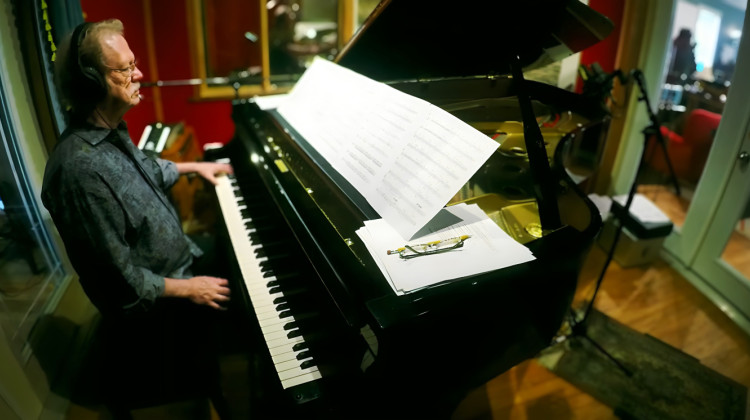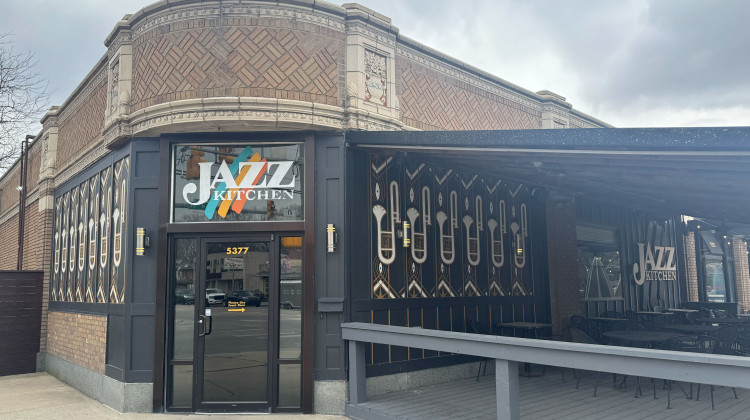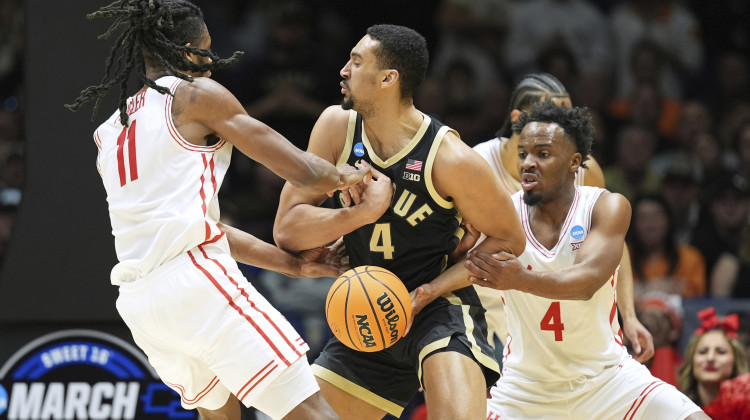
The sculpture's 22 large, colorful fall leaves represent the average number of veterans who commit suicide each day.
Photo courtesy Elder HeartAs part of an ongoing WFYI Veterans Coming Home initiative, WFYI’s Leigh DeNoon reports on one Hoosier veteran who has turned to public art as a public awareness campaign to lift the veil from an invisible epidemic – veteran suicides.
Magnus Johnson served three tours of duty –first as an Army Private Combat Engineer in Ramadi, Iraq, and then as a Special Forces Staff Sergeant Green Beret in Afghanistan. But, after eight years in the service and those three combat tours, he crashed when he got home.
“You know, it dawned on me, OK, you know this is what they’re talking about. Transition. I kind of underestimated it. I didn’t think it was that big of a deal. I thought that I would adapt. When you’re still in and then you’re home on leave and such, it’s one thing,” Johnson said. “But then when it’s completely over, you start to realize that your brain is kind of rewired more for adrenaline, for risk for different proper responses to your environment. Think of it like driving a corvette and suddenly you hit a brick wall. That momentum, it’s done. It’s finished. It’s stopped.”
One-fifth of veterans coming back from Iraq and Afghanistan suffer from post traumatic stress disorder and depression, hindering the transition back to civilian life. For Johnson, coming home meant coming to terms with the past, and making sense of the present.
“I’m not a Green Beret, I’m not in the military I don’t have a mission, I’m not with the men and women I trust,” he said. “It’s over. Get a job. Go do - this. But I just didn’t care.”
And on top of that, Johnson started losing military friends to suicide. He finally found a creative outlet for his stress after befriending Brown County artist, metal and stone sculptor Jim Connor.
Connor taught him to weld and work with different metals. Using his hands and refocusing his mind on creating art led to an epiphany. Why not invite other vets to help create large public art pieces – to bring much needed attention to veteran issues?
And so, about a year ago, the organization Elder Heart was born. The first of their large public art projects will be dedicated Saturday in Nashville – an Indiana tourism hotspot that draws an estimated 3 million people each year.
“Art is a mechanism to get involved in your community to make something that’s going to last a long time – that’s going to shape the culture of place you live in. Art can be beneficial – I mean, I love it – but it’s not the sole healing factor,” Johnson said. “A lot of it is participation, helping others, sharing the story, telling your story. Think of every veteran who’s been a part of this project is associated with it that plaque that tells 3 million people what’s going on.”
At 20 feet tall, and at a prominent intersection on Nashville’s main road, the sculpture “Soaring” is hard to miss. Its 22 large, colorful fall leaves represent the average number of veterans who commit suicide each day. Jim Connor designed “Soaring”, while several veterans volunteered alongside Magnus Johnson, artists and Brown County residents – to create it.
“I think the whole art experience is also very healing for these guys to work on things. Because it starts dialogue among them, you know, that I’ve been privileged to hear. It’s made me more aware of what’s going on and really to care about it,” Connor said. “To really look at the issue and – it’s opened up some really – discussions I think that I would have never had in my lifetime with people about what we do as human beings and how we try to heal as human beings.”
In keeping with their efforts to bring awareness to the staggering veteran suicide rate, Elder Heart’s next large public art piece is to be delivered in September to Rhode Island for a memorial honoring Rob Guzzo, a highly decorated Navy SEAL who took his own life.
The dedication ceremony for the sculpture “Soaring” in Nashville, Ind. will be held from 5 to 7 p.m. Saturday at 10 N. Van Buren Street.
Click here for information about the Veterans Coming Home initiative and for veteran resources.
 DONATE
DONATE







 View More Articles
View More Articles


 Support WFYI. We can't do it without you.
Support WFYI. We can't do it without you.